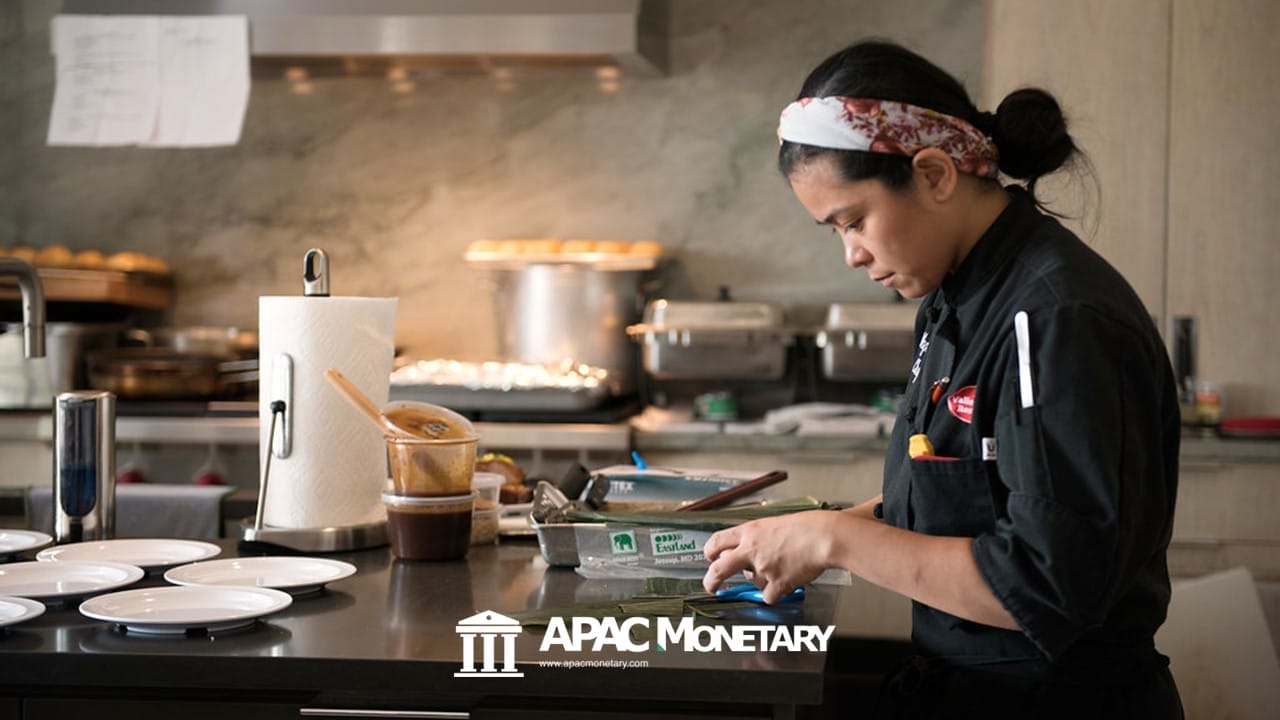Table of Contents
In a place where the air is filled with the delicious smell of sizzling street food and the sweetness of tropical fruits, starting a food business in the Philippines is not just a dream—it’s an exciting adventure waiting to happen. With its rich culinary heritage and a growing love for different flavors, the country offers endless opportunities for anyone looking to start their own food business. Whether you want to share your family’s special recipes or bring international cuisine to local diners, this lively setting is perfect for bringing your food ideas to life.
Feeling overwhelmed about where to start? Don’t worry; we’ve put together six practical tips to help you kickstart your own food business in this dynamic environment. From keeping up with market trends to perfecting your recipes, these steps will guide you toward turning your love for food into a successful venture. So put on your apron, and let’s jump into the exciting world of Philippine cuisine!

Starting a Food Business in the Philippines: Is it Easy or Difficult?
Starting a food business in the Philippines comes with both exciting opportunities and challenging hurdles. The country’s rich culinary landscape offers a diverse range of options for aspiring entrepreneurs, from humble street food to upscale dining experiences. The demand for new and diverse flavors allows for innovation and creativity to carve out a unique niche in the market. Moreover, the lower startup costs compared to many Western countries can be an attractive incentive for those looking to pursue their culinary dreams.
However, it’s important to recognize the complexities of navigating the local regulatory landscape. Obtaining permits, ensuring compliance with health standards, and navigating varying zoning regulations across different regions can pose significant challenges. The intense competition in urban areas requires businesses to continuously adapt to changing consumer preferences and economic conditions.
In essence, starting a food business in the Philippines isn’t just about the degree of difficulty—it’s about artful preparation, adaptability, and resilience to thrive amidst the complexities of the business landscape.

1. Research Your Market and Target Audience
Creating a thriving food business in the Philippines starts with a deep understanding of the market and the people you aim to serve. Immerse yourself in local food culture by exploring street markets, community gatherings, and dining hotspots to stay in tune with current trends and customer preferences. This hands-on approach not only helps you identify popular dishes but also reveals opportunities for you to introduce your unique offerings.
To gain deeper insights, use surveys and social media polls to understand consumer habits and preferences. Engage directly with potential customers to learn about their favorite flavors and dining experiences. Building this dialogue will provide valuable feedback that will shape your menu decisions and help you build a loyal community around your brand from the outset. Remember, by understanding how cultural values and lifestyle trends influence eating habits, you can develop innovative concepts that genuinely resonate with Filipino consumers, making your venture more relatable and appealing in a competitive marketplace.
2. Create a Unique and Delicious Menu
Crafting a one-of-a-kind and mouthwatering menu is essential for any thriving food business, particularly in the dynamic culinary scene of the Philippines. To truly stand out in this flavorful landscape, consider infusing local ingredients with international flair. This fusion not only honors our vibrant culture but also caters to varying tastes seeking unique dining experiences. Think about offerings like adobo tacos or sinigang ramen—dishes that deeply resonate while captivating customers with their innovative concepts.
Furthermore, integrating seasonal selections can bring an exhilarating dimension to your menu. Embracing nature’s rhythms to inspire daily or weekly specials keeps your offerings fresh and underscores sustainability, a key value for many discerning modern consumers. It’s also crucial to stay attuned to dietary trends; creating options for plant-based eaters or health-conscious individuals can attract a wider customer base. Ultimately, your menu should narrate a compelling story that mirrors your brand’s vision while sparking curiosity and delight among patrons eager for their next gastronomic escapade.
3. Develop a Solid Business Plan
Crafting a robust business plan is essential for the success of any food business in the dynamic Philippine market. It should outline your culinary vision and include a comprehensive market analysis to understand your target audience and competitors. By staying attuned to local preferences and emerging trends, you can tailor your offerings to meet specific demands, whether that’s traditional Filipino cuisine or innovative fusion foods.
Financial projections are vital for gauging startup costs, operational expenses, and potential revenue streams. Developing detailed budgets will help identify the required funding and areas for future investments. Incorporating engaging storytelling into your plan can enhance your brand identity, such as narratives about locally sourced ingredients or sustainable practices that resonate with modern consumers. This holistic approach ensures that you’re not just selling food but creating an experience that builds customer loyalty in a thriving marketplace.
4. Register Your Business with Legal Requirements
Once you’ve laid the groundwork for your food business, it’s essential to navigate the legal landscape, but it doesn’t have to be daunting. Registering your business is not just a procedural step; it’s a crucial part of establishing credibility and safeguarding against potential liabilities. In the Philippines, you’ll need to choose between different business structures such as sole proprietorship, partnership, or corporation, each with its own set of requirements. Whether it’s Department of Trade and Industry (DTI) registration for sole proprietors or Securities and Exchange Commission (SEC) registration for partnerships and corporations, we’re here to guide you through the process.
Going beyond just registering your business name, getting the necessary permits and licenses can seem overwhelming, but it’s essential for operating legally. Depending on your menu offerings, whether it’s a food stall or a full-service restaurant, you may need a Food Safety Certificate from the local health department and sanitation permits to comply with local regulations. Don’t forget to obtain a Bureau of Internal Revenue (BIR) tax identification number: not only does it legitimize your business, but it also helps with formal transactions, enhancing customer trust. By ensuring that all legal requirements are met from the start, you’re setting the stage for smoother operations in the future and showcasing professionalism to suppliers and customers.
5. Choose the Right Location for Success
Launching a food business in the Philippines can be challenging, but choosing the right location is crucial. You need to think beyond just foot traffic and take into account the local community’s preferences and needs. For example, an area with young professionals may benefit from quick, healthy meal options or trendy cafes, while suburban neighborhoods may prefer comfort food and larger dining establishments for families.
Also, it’s important to consider leveraging technology to gain insights that traditional metrics might miss. By using data analytics tools to assess online search trends and social media activity, you can uncover hidden opportunities for your food business in the Philippines. Establishing a presence near colleges or busy marketplaces could help create clusters of demand, maximizing both visibility and profitability. It’s essential to not only meet current demand but also anticipate future trends by staying tuned to evolving tastes, putting you ahead of your competitors.
6. Utilize Social Media for Marketing Strategies
The impact of social media on the food business in the Philippines cannot be understated. Platforms such as Facebook and Instagram offer unparalleled opportunities to engage with potential customers. By showcasing your culinary creations through vibrant imagery and compelling content, you can establish a strong brand identity. Sharing behind-the-scenes videos of your cooking process and customer testimonials can help foster a community that is deeply invested in your culinary journey.
Furthermore, tapping into social media advertising can yield significant results by allowing you to target specific demographics within the diverse Filipino market. For instance, implementing localized promotions or contests can incentivize online followers to visit your physical store or place orders directly through your website. Collaborating with local influencers who boast substantial follower engagement is also a promising strategy for enhancing visibility while bolstering credibility—a pivotal element in forging trust for any food business in the Philippines. In today’s digital age, leveraging social media not only serves as a promotional tool for your offerings but also has the potential to transform one-time customers into devoted advocates for your brand.
7. Build Relationships with Suppliers and Customers
In the food business in the Philippines, it’s truly crucial to build strong relationships with suppliers and customers. Your suppliers are not just sources of ingredients; they can be your allies in navigating local markets and seasonal changes. Nurturing these connections allows you to negotiate better terms, gain insights into sourcing premium products, and maintain consistent quality to keep your own customers coming back. Regular communication, honesty, and a dedication to mutual growth can transform a standard supplier relationship into a collaborative partnership.
Equally important is cultivating loyalty among your customer base. In an age where consumers value brands that share their values, engaging with your audience through social media or community events can help create enduring connections. Encouraging feedback and having conversations about their preferences not only makes customers feel valued, but also helps tailor your offerings to meet market demand more effectively. Remember, in the dynamic landscape of the food business in the Philippines, satisfied customers often spread word-of-mouth recommendations that can greatly amplify your success far beyond traditional advertising methods.
Consider Food Safety and Quality Standards
When starting a food business in the Philippines, it is essential to prioritize compliance with food safety and quality standards. These standards are not only required by law but are also crucial in establishing trust with consumers. The Philippine Food and Drug Administration (FDA) has put in place stringent guidelines to ensure that all food served is safe and meets necessary health requirements. Staying updated on these standards demonstrates your commitment to operating a responsible and trustworthy business, which is highly valued by health-conscious consumers.
Additionally, prioritizing food safety practices can be a key differentiator in a competitive market. By implementing rigorous quality control measures throughout the entire production process, from sourcing ingredients to final packaging, you can enhance the safety and appeal of your products. Factors such as ensuring traceability of ingredients and maintaining transparency in your processes showcase your dedication to providing high-quality products. This assurance can convince customers that they are making healthy choices by supporting your food business in the Philippines. Ultimately, this holistic approach fosters customer loyalty and safeguards your reputation in an industry that is constantly evolving.
Sweet Ending: Simple Steps to Start a Food Business in the Philippines
Launching a food business in the Philippines can be exciting and challenging. To succeed, start by researching the local market to understand preferences and find a unique niche. Consider cultural influences and current trends when developing your unique selling proposition. Creating a strong brand identity, including a catchy name, appealing logos, and a presence on social media, will help build customer loyalty and awareness. Lastly, focus on product quality and customer experience to stand out in the competitive food industry in the Philippines. By prioritizing these key elements from the start, you can establish a strong foundation for growth and sustainability.











